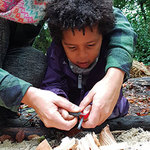
Download the PDF of this article
 In the picturesque Cornish village of Charlestown – well known as a filming location for the BBC series Poldark – a group of 20 pre-school children start their day with a walk to a patch of woodland where they prepare breakfast on an open fire.
In the picturesque Cornish village of Charlestown – well known as a filming location for the BBC series Poldark – a group of 20 pre-school children start their day with a walk to a patch of woodland where they prepare breakfast on an open fire.
‘Porridge with cinnamon and raisins or toasted bagels and warm milk are usually the morning favourites,’ says Tom Richardson, nursery manager at Naturally Learning Charlestown in St Austell and senior outdoor manager for the other four nurseries in the chain.
‘Each morning a different child helps us to light the fire using a flint and steel. All meals are eaten outdoors, except for in extreme weather conditions, and the children get involved in all aspects of food preparation throughout the day.’
Register now to continue reading
Thank you for visiting Nursery World and making use of our archive of more than 35,000 expert features, subject guides, case studies and policy updates. Why not register today and enjoy the following great benefits:
What's included
-
Free access to 4 subscriber-only articles per month
-
Unlimited access to news and opinion
-
Email newsletter providing activity ideas, best practice and breaking news
Already have an account? Sign in here









